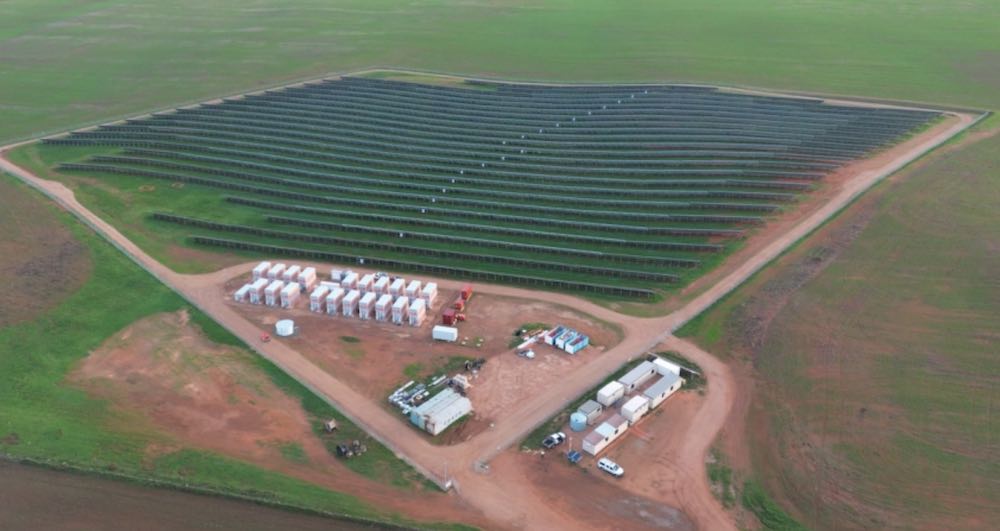Vanadium could be the answer to using solar and wind round the clock, potentially silencing critics who say the technologies are useless when the sun doesn’t shine and breeze isn’t blowing.
So-called flow batteries may be more expensive up front but last for decades, don’t catch fire and can store and dispatch sunshine for 10 to 18 hours – in contrast, the backers say, to rows of lithium-ion batteries springing up around the country are handy backup to meet peak energy demand for a few hours at a time.
Australia has vast reserves of vanadium but most of the world’s supply is sourced from China, Russia and South Africa and goes into making steel alloy.
That is rapidly changing as allies eye the potential of an end-to-end chain – from mine to electricity grid – in Australia.
Chief commercial officer Matt Harper at Invinity, the British company behind the southern hemisphere’s largest vanadium flow battery, told AAP the company is in talks with local developers to use Australian vanadium within two to four years.
“Lithium batteries have done a great job at showing many problems on the grid can be solved by batteries,” he says.
“We want to be able to take solar power and make it available 24 hours a day.”
In coming years, Invinity aims to use the technology with vanadium that is mined in Australia and manufacture for the domestic market.
Because the technology is built around vanadium that is suspended in the electrolyte, a solution inside the battery, it doesn’t require giga-factories to make them.
“We are definitely looking at doing that in-country,” Mr Harper says.
He says blending the vanadium into the liquid electrolyte is an intermediate step that could also be done in Australia.
That would bring a technology invented in Australia back home. It was created in the 1980s by Professor Maria Skyllas-Kazacos and her team at UNSW and Mr Harper worked for the company that took it to North America.
Invinity’s Port Pirie VFB in South Australia is fully commissioned and going through its final technical tests before connecting to the national electricity market.
Backed with $5.7 million in seed funding from the Australian Renewable Energy Agency (ARENA) in 2020, officials say the set-up demonstrates the potential for grid-connected VFB to provide energy and frequency control services.
Coupling a six megawatt solar plant with an eight MWh flow battery at the site will produce 10 GWh of dispatchable solar power yearly.
“These are assets that serve the grid not for five or 10 years, which is how long a lithium-ion battery lasts, but for decades,” Mr Harper says. (Editor’s note: Lithium-ion batteries actually have a warranty for 15 years).
Harper says the technology is at the point where it doesn’t require direct subsidies but does need the right regulatory thinking.
If there’s a battery than can deliver over 25 years, then a contract should be available to lock in that generation and storage for that period and give certainty to developers and investors, he explains.
The Australian Energy Market Operator and the federal government’s first Low Emissions Technology Statement identified the technology as having potential to support industrial-scale, low-emission energy projects.
ARENA CEO Darren Miller says flow batteries are an “exciting technology” to address the emerging energy storage requirement, complementing established technologies like pumped hydro and lithium-ion batteries.
Non-flammable, vanadium flow batteries can be stacked up at utility scale and offer more flexibility in where they are built compared to pumped hydro energy storage.
In July, a utility owned by the Western Australia government announced plans for a vanadium flow battery at Kununurra as part of a long-duration energy storage trial to see what works best in harsh conditions.
Horizon CEO Stephanie Unwin said the pilot program would test its ability to provide long periods of 100 per cent renewable energy in a regional energy system.
An energy subsidiary of Perth-based developer Australian Vanadium Ltd (AVL) will supply, install and commission the energy storage system – also sourced from manufacturer Invinity.
Several potential vanadium mines have been granted major project status over the years by federal and state governments but none have got off the ground.
AVL is developing a project south of Meekatharra in WA for an ethically sourced supply of vanadium to global steel, battery and critical metals markets, with a processing plant planned.
The mining company expects to be able to provide Invinity with electrolyte from next year, with the plant to be commissioned by the end of 2023.
Earlier this month, Invinity’s Mr Harper advised the House of Lords Science and Technology Committee on their use in the United Kingdom, where they are considering rapid deployment.
In place for decades in China, the technology – and need for reliable supply chains – is also on the minds of European governments who need industrial-scale clean energy.
China has pushed hard on VFB and has a number of companies who are champions of the technology, while lithium batteries are the cornerstone of their electric vehicle industry.
 Image supplied by Yadlamalka
Image supplied by Yadlamalka









